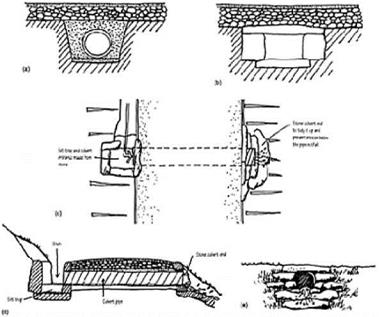Path construction is similar to that described above except for two factors: the need for more drainage, and the problems of the surface sinking into the wetter, weaker soils beneath. Drainage is provided by open ditches alongside each side of the path; these should lead water away without discharging directly into watercourses. The path can be prevented from collapsing into the ditches by placing stones or timber along its edges to retain the surface, or by setting the ditches a short distance away with side drains leading to them from the crowned surface of the path.
The problem of the surface material’s sinking into and mixing with softer ground beneath can be over come by laying a geotextile mat on the excavated surface before laying the surfacing. The turves replaced at the path edges help to keep the geotextile buried, and tidy up the overall effect.
 |
Culvert construction: (a) Modern culverts are easily made from lightweight plastic tubing laid in a trench cut to a fall across the path. (b) A stone culvert can be made from local materials. This is set beneath the path. (c) A plan view shows the layout of the culvert—its entrance contains a silt trap and its exit is dressed with stone. (d) A section through the culvert, showing the silt trap, the retained path edges and the culvert mouth set around with stone. (e) The culvert exit is tied into the path edge using stone to prevent erosion and to make a tidy result.
 |
An example of a box culvert made from local stone and covered in large flat slabs. This is an attractive and durable solution. Glen Affric, Scotland.
|
|
A typical section diagram to show path
construction on firm, freely drained ground: (a) Turves are stripped and retained to be used to tidy the edge of the path after construction. (b) The path route is excavated down to firm subsoil, and large stones or roots are removed. (c) Around 150 mm (6 in.) of crushed stone is laid and rolled. (d) Smaller stone is laid and rolled for the surface, raised in the centre to help shed water and prevent potholes from developing.




